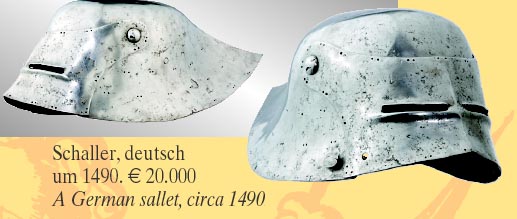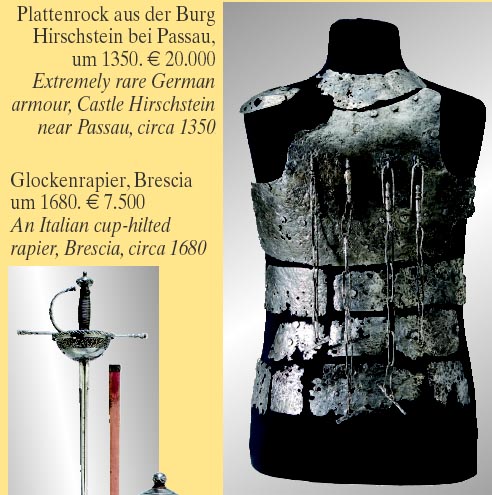Posts: 5,981 Location: Birmingham, Alabama
Mon 19 Feb, 2007 12:37 pm
Late sallet, rare 14th c. armour
Posts: 2,121 Location: Northern Utah
Mon 19 Feb, 2007 1:43 pm
That is an awesome COP, has the chains still!!! I wish I had 20,000 euro's around. I wish some of this stuff would end up in a museum so I could see it in person..... Perhaps....
RPM
Posts: 5,981 Location: Birmingham, Alabama
Mon 19 Feb, 2007 1:47 pm
By the way, the PDF from which I copied this shows the items a bit more clearly and with proper color correction. Go to the HH site and follow the links to the arms and armour items in the auction preview for auction #52. Download part IV.
Posts: 5,981 Location: Birmingham, Alabama
Mon 19 Feb, 2007 1:53 pm
See if this is a bit better:
 Attachment: 122.02 KB
Attachment: 122.02 KB
[ Download ]
Posts: 123 Location: Durham, NC on my way to Iraq
Tue 20 Feb, 2007 5:55 am
Can someone elaborate what the purpose of the chains are?
Mike
Posts: 64 Location: Denmark/ Fredericia
Tue 20 Feb, 2007 6:22 am
I think the chains are for securing the warriors weapons.
In Ospreys Men at Arms Series
German Medieval Armies 1300-1500
some of the plates show how dagger, and swords are secured in this manner.
Best regard Klaus
Posts: 9,570 Location: Dayton, OH
Tue 20 Feb, 2007 6:24 am
Various effigies and brasses show that these chains attached to sword, dagger, and/or helmet to prevent them from being lost during combat.
Posts: 782 Location: Upstate New York
Tue 20 Feb, 2007 7:55 am
| Chad Arnow wrote: |
| Various effigies and brasses show that these chains attached to sword, dagger, and/or helmet to prevent them from being lost during combat. |
And it was especially common in Central Europe. Many German effigies show these chains. :)
Posts: 2,121 Location: Northern Utah
Tue 20 Feb, 2007 7:59 am
Adding on to the chains. It seems to be shorted lived in western europe but continued for decades in central europe. Not sure about the further east countries though.
One question I had regarding chains. Did they use this configuration in Italy? I do not recollect any chains in italian artwork at all?
Once more cool find. I hope a museum or someone I knows buys it....
RPM
Posts: 8,310 Location: Montreal,Quebec,Canada
Tue 20 Feb, 2007 8:19 am
| Chad Arnow wrote: |
| Various effigies and brasses show that these chains attached to sword, dagger, and/or helmet to prevent them from being lost during combat. |
Any opinion about having your weapons and armour pieces chained to your breastplate ?
I can see it being useful sometimes but a possible hazard at other times: A 6 pound helm dragging from a chain on your breast getting in the way or tripping over ( probably not if the chain was short but the helm could get wedged on something in a tight spot ? ).
A sword dangling from the chain might end up bouncing around in random directions in the confusion of a crowded fight also.
Oh, and the chains couldn't have helped with sword handling.
A fashion for German armour for a time but if it was very useful it should have caught on elsewhere and been continued later I think ? Maybe it just looked " cool " and seemed like a good idea until some Knight(s) got killed because of the negatives.
Can you see a polearm like a Bill with nice hooks on it getting hold of some of these chains pulling weapons out of hands or tugging at the helm as another opponent takes advantage of the tangled up knight to stab a rondel through a visor or smash with a mace. :eek:
Imagine trying to shovel snow of your walk with the shovel chained to your body and the chain getting caught on something: A tree branch, a side rear window, a picket fence, a bicycle handle bar or any other thing. Oh even better a side rear window on a moving car. :p :eek: :lol:
Posts: 226 Location: Maryland, USA
Tue 20 Feb, 2007 8:38 am
| Jean Thibodeau wrote: |
A sword dangling from the chain might end up bouncing around in random directions in the confusion of a crowded fight also. |
I think (at least this is what I have heard) that the point is so that if the weapon is dropped it can be picked up, you wouldn't let it dangle, you would retrieve it. It would be easier than retrieving a sword dropped to the ground (I would assume?).
-James
Posts: 9,570 Location: Dayton, OH
Tue 20 Feb, 2007 9:00 am
| Randall Moffett wrote: |
One question I had regarding chains. Did they use this configuration in Italy? I do not recollect any chains in italian artwork at all?
|
The grave stone of Colaccio Beccadelli shows them. The one for the helm is best visible. The helm is slung over his shoulder.
 Attachment: 50.01 KB
Attachment: 50.01 KB
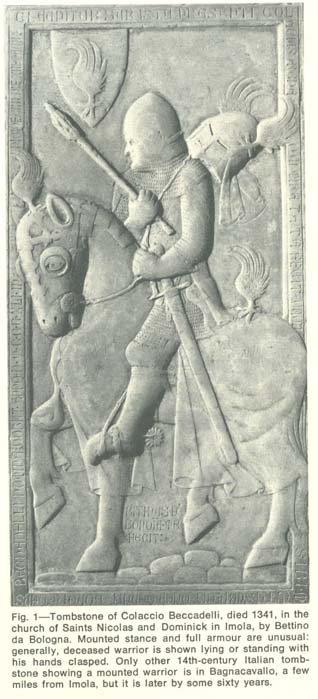
 Attachment: 123.03 KB
Attachment: 123.03 KB
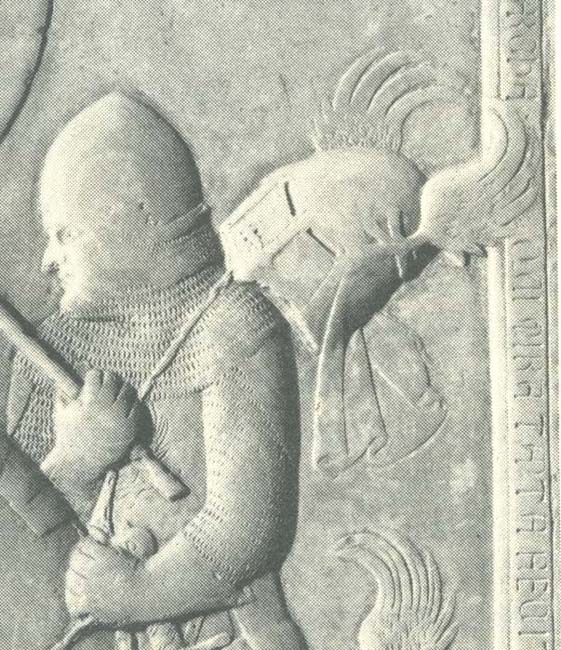
Posts: 9,570 Location: Dayton, OH
Tue 20 Feb, 2007 9:04 am
| Jean Thibodeau wrote: |
Any opinion about having your weapons and armour pieces chained to your breastplate ?
I can see it being useful sometimes but a possible hazard at other times: A 6 pound helm dragging from a chain on your breast getting in the way or tripping over ( probably not if the chain was short but the helm could get wedged on something in a tight spot ? ).
A sword dangling from the chain might end up bouncing around in random directions in the confusion of a crowded fight also.
|
Oakeshott noted that the chains needed to only be the length from chest to hand or chest to just above your head (for a helm). They're not 6 feet long or something. :) Those items not only had monetary value, they had practical value ont hat battlefield. Folks were interested in not losing the items.
The overall practicality of the system may be testified to by the shortish length of time it was fashionable.
Posts: 8,310 Location: Montreal,Quebec,Canada
Tue 20 Feb, 2007 9:06 am
| J. Bedell wrote: |
| Jean Thibodeau wrote: |
A sword dangling from the chain might end up bouncing around in random directions in the confusion of a crowded fight also. |
I think (at least this is what I have heard) that the point is so that if the weapon is dropped it can be picked up, you wouldn't let it dangle, you would retrieve it. It would be easier than retrieving a sword dropped to the ground (I would assume?).
-James |
Well that would be the plan but plans have a way of going wrong. Might work at times but in a tight press ? O.K. maybe it would make retrieving your sword at some point faster and easier but a lot of negative outcomes are possible also as I tried to imagine before.
I guess it's the glass half full or half empty situation: If the chain helps you out more often than it's a nuisance or a hazard.
Still if it was much more useful having chains than not having chains I would have expected to see chains still used with 15th / 16th Century armour.
As a personal choice I would give the chains a pass and have a page follow me around with a bag full of spare swords: The whole swords / golf bag / caddy solution to dropping swords. ( partly joking partly serious. ;) )
Posts: 250 Location: Irvine Spectrum, CA
Tue 20 Feb, 2007 9:09 am
With all that stuff hanging off the chains, it would seem that a simple "pirouet" manuever in close combat could be opponent fatal... :lol:
Posts: 782 Location: Upstate New York
Tue 20 Feb, 2007 9:19 am
| Jean Thibodeau wrote: |
[Any opinion about having your weapons and armour pieces chained to your breastplate ?
A fashion for German armour for a time but if it was very useful it should have caught on elsewhere and been continued later I think ? Maybe it just looked " cool " and seemed like a good idea until some Knight(s) got killed because of the negatives.
|
The fashion for chains attaching helm, dagger, and sword to the breastplate (or even hauberk - there are a few examples that suggests that the chains could be attached to the hauberk, and not necessarily to a solid breastplate) seems to have lasted longest in Germany, but I think it was seen elsewhere. However, it is possible that the chains seen elsewhere are due to German influence.
Such chains are seen on the brass of Ralph de Knevynton, circa 1370. His brass is of a different style than other English brasses of the period, and it may have been made in Flanders (?). The brass of William Wenemaer of Ghent, circa 1325 shows these chains. In this case the chains appear to attach directly to the hauberk, and not a breastplate. The chains are also seen on a few Italian effigies, such as the very elaborate sculpture of Lorenzo Acciaiolli of circa 1350. However, some of the Italian depictions of the chains are on the effigies of Germans in Italian service, like Johann Spirer de Gleyspalsen. There is at least one image of St. Stephen from a Hungarian manuscript that shows these chains, but again it probably shows German influence.
As for the possible hindrance offered by these chains, Ewart Oakeshott had some interesting things to say about this point in The Archaeology of Weapons:
| Ewart Oakeshott wrote: |
Perhaps the most cumbersome items in the clutter of fourteenth-century armament were the stout chains whereby sword, dagger and helm were attached to the person. These had indeed a most practical purpose - to prevent these essentials from being completely lost if they were knocked out of the hand or off the head of a warrior in a fight. We see then on monuments and in pictures from the late thirteenth century almost to the end of the fourteenth, particularly in Germany, where they seem to have been most popular. We may think it almost inconceivable that a man could fight encumbered by a 4-ft chain joining his sword-hilt to his breast-plate; surely it would wrap itself round his sword-arm or catch round the head of an opponent's horse, or get tangled up with other people's weapons? and if he did lose his sword in the violent and continually shifting movement of a melee on horseback, would it not get mixed up with the spurs and feet of anyone who came near? It seems that there must have been a risk of this sort of thing happening, yet the chain would not need to be much longer than the distance from the fist to the right ribs with the arm fully extended, a length of 3 to 4 ft. If it fell and hung down from the chest, the end of the chain itself would reach to a little below the knee, with the sword's point 3 ft or so below that - well clear of the ground. It must have been practical in use, or it would not have been popular for so long. |
Stay safe!
 Attachment: 72.39 KB
Attachment: 72.39 KB

St. Stephen from the Illuminated Chronicle of circa 1360.
Last edited by Richard Fay on Tue 20 Feb, 2007 9:56 am; edited 1 time in total
Posts: 782 Location: Upstate New York
Tue 20 Feb, 2007 9:42 am
| Randall Moffett wrote: |
Adding on to the chains. It seems to be shorted lived in western europe but continued for decades in central europe. Not sure about the further east countries though.
One question I had regarding chains. Did they use this configuration in Italy? I do not recollect any chains in italian artwork at all? |
Hi Randall! :)
As Chad already posted; yes, these chains were used in Italy. I also responded to your question in my previous post (one that I must have been typing in at the same time as Chad's response).
I already mentioned the effigy of Lorenzo di Nicocolo Acciaiuoli (spelled a bit differently in my previous post - some of these names seem to have multiple spellings depending on what source is used), a Tuscan effigy of circa 1353. There are others that show the chains:
- the tomb slab of Filippo dei Desideri, from Romagna, circa 1325.
- the tomb slab of Bernardino dei Baranzoni, from Lombardy, circa 1345-50.
- effigy of Giovanni di Castruccio Castracane, from Tuscany, circa 1343.
- effigy of Gherarduccio de Gherardini, from Tuscany, circa 1331.
- wall-painting of "St. Martin Renouncing the Sword" by Simone Martini, in Montefiore Chapel, Assisi, circa 1317.
I hope this provided enough examples to show that the chains were used in Italy. However, they do seem to have remained most popular in the German-speaking lands.
Stay safe!
 Attachment: 62.08 KB
Attachment: 62.08 KB
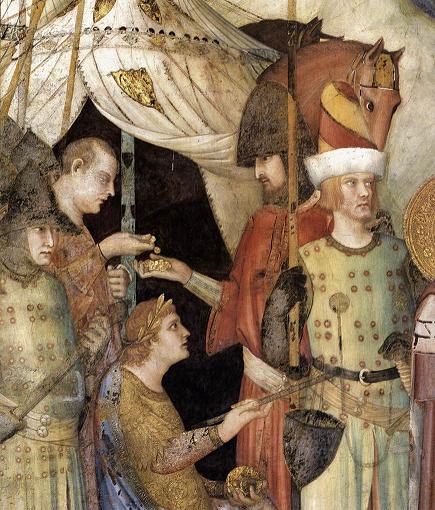
Saint Martin Renounces his Weapons (detail), by Simone Martini.
Posts: 2,121 Location: Northern Utah
Tue 20 Feb, 2007 11:18 am
Thanks for those examples. I had not seen many of those before. I had noted from English artwork it seems most COP's don't have chains. I have a few that do but most seem to have not done so. I wonder if battle methods are why germany seemed to use them longer. Does it seem to you that italy used them more than England did? I think we can give the prize for most used to the germans though :D .
'
RPM
Posts: 782 Location: Upstate New York
Tue 20 Feb, 2007 1:30 pm
| Randall Moffett wrote: |
Thanks for those examples. I had not seen many of those before. I had noted from English artwork it seems most COP's don't have chains. I have a few that do but most seem to have not done so. I wonder if battle methods are why germany seemed to use them longer. Does it seem to you that italy used them more than England did? I think we can give the prize for most used to the germans though :D .
|
I know the brass of Sir Ralph Knevynton shows the chains, but I'm not aware of many other English brasses or effigies that do. I think Sir Ralph's brass was actually made on the continent, though. The brass of Sir John de Northwode from the Isle of Sheppey, circa 1340, shows one on his chest that's probably attached to his chest. There are chains shown on the effigy of a knight in Swine priory, circa 1372.
There may be more of these depictions in Italian art, but they do seem to be most prevalent in German art. There are too many to list in German period art.
Posts: 110 Location: Topeka, Kansas
Tue 20 Feb, 2007 4:23 pm
Had to share this one, which is the first place I ever saw this in action:
http://www.wga.hu/art/e/eyck_van/jan/21paele/21paele3.jpg
You
cannot post new topics in this forum
You
cannot reply to topics in this forum
You
cannot edit your posts in this forum
You
cannot delete your posts in this forum
You
cannot vote in polls in this forum
You
cannot attach files in this forum
You
can download files in this forum
